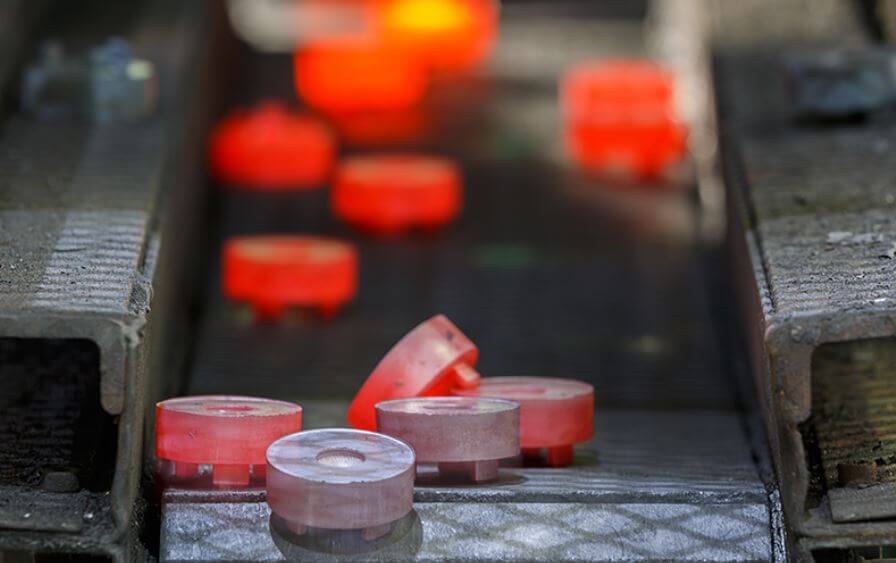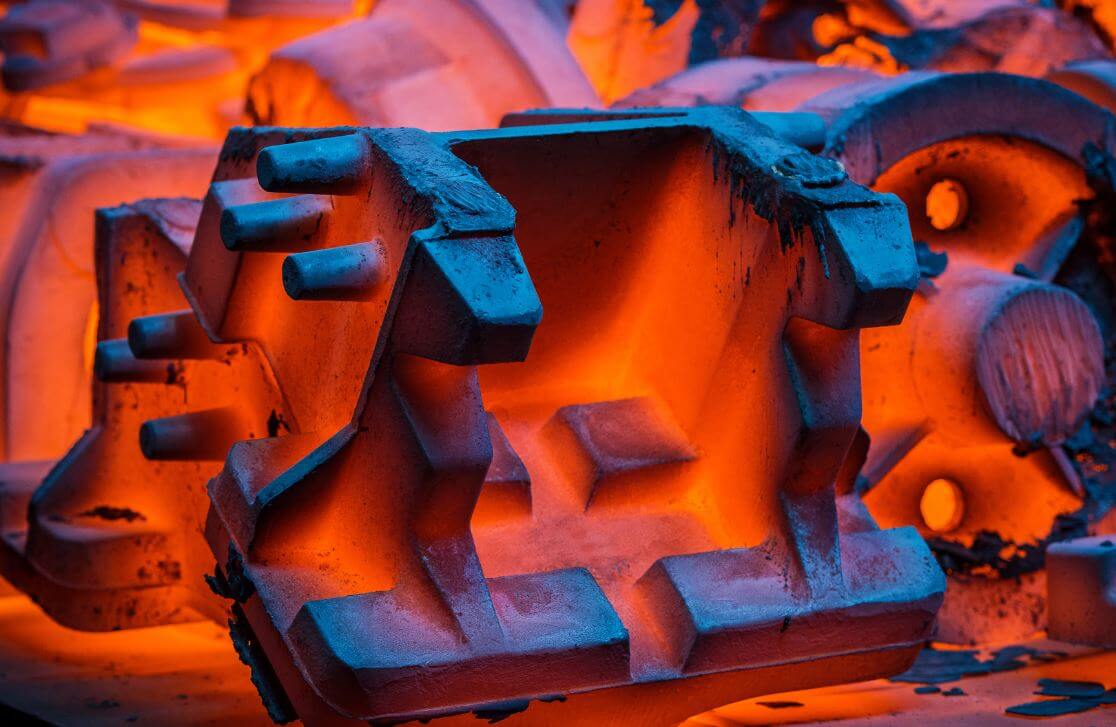Niagara Investment Castings offers our clients a wide variety of options of the heat treatment process used for castings to enhance the mechanical strength, corrosion resistance, and versatility of the many metal alloys we offer.
Our expertise and experience in working with our heat treatment partners ensures our clients castings are provided at the exact specification for optimum performance. We offer the most advanced heat treat equipment including vacuum processing, charting of cycles, and an inhouse metallurgical lab with hardness testing across a full range of testing criteria.
If you require assistance with what heat treatment would work best for your specific application, please just ask your Sales Representative, and we will be happy to assist you with any of the heat treatment processes applicable for your investment castings.

What are Some of the Typical Heat Treatment Processes Used for Castings?
Depending on the alloy, the family of the metal (ferrous based, nickel based, copper based, etc), and the desired final properties of the cast component, there are a number of heat treatment processes that Niagara Investment Castings can provide, including :
Solution Anneal Heat Treatment Process
- This heat treatment process involves heating the castings to 1950 degrees F or higher, depending on the alloy, and quickly quenching into water to lock any carbides into solution, hence the name. This process is used exclusively for stainless steels and some high alloy nickel based alloys, to obtain optimum corrosion resistance and machinability of the castings.
Annealing Heat Treatment Process
- Annealing consists of heating the castings to a temperature high enough to effect a phase transition at the upper critical range, and then cooling at a rate that will produce a refined microstructure, either fully or partially separating the constituents. The rate of cooling is generally slow. Annealing is most often used to soften a casting to improve machinability.
- Most non-ferrous alloys that are heat-treatable are also annealed to relieve the hardness of cold working. These may be slowly cooled to allow full precipitation of the constituents and produce a refined microstructure. Non-ferrous alloys are often subjected to a variety of annealing techniques, including “recrystallization annealing”, “partial annealing”, “full annealing”, and “final annealing”.
- Ferrous alloys are usually either “full annealed” or “process annealed”. Full annealing requires very slow cooling rates, in order to form coarse pearlite. In process annealing, the cooling rate may be faster; up to, and including normalizing. The main goal of process annealing is to produce a uniform microstructure.

Normalizing Heat Treatment Process
- Normalizing is a technique used to provide uniformity in grain size and composition (equiaxed crystals) throughout an alloy. The term is often used for steel and iron castings that have been austenitized and then cooled in the open air. Normalizing not only produces pearlite but also martensite and sometimes bainite, which gives harder and stronger steel but with less ductility for the same composition than full annealing.
- In the normalizing process the steel is heated to about 100 degrees F above its upper critical temperature limit, held at this temperature for some time, and then cooled in air.
Harden and Tempering Heat Treatment Process
- This heat treatment process is widely used for many alloyed steels to increase hardness, strength, and toughness. The castings are heated to anywhere between 1500 and 1750 degrees F and quickly “quenched” into either oil, water, or even just air, to form a hardened microstructure in the casting.
- Hardening is almost always followed up by a “tempering” process to bring the hardness back down to specific hardness number based on a full range of test scales utilized. The tempering is a lower temperature soak applied to allow the hardened structure to revert to a more mixed microstructure of the hard phases of the steel, with some softer phases in the microstructure.
Vacuum Heat Treatment Process
- The vacuum heat treatment process involves heating of the castings past 1500 degrees F in a vacuum atmosphere for the high temperature phase of many of the traditional processes. This provides an oxygen free environment during the high temperature processing, preventing the scaling typically associated with the oxidation on the surface of the casting. This also prevents decarburization of the casting surface.
- Alternately, a heat treatment process that can achieve a similar result is to pump in an endothermic or exothermic atmosphere into non-vacuum heat treat equipment. These atmospheres are produced to achieve similar results to vacuum, whereas the carbon content of the atmosphere is matched to the carbon content of the casting, again preventing decarburization and scaling, but not to the same degree as vacuum processing can achieve.
Precipitation Hardening Heat Treatment Process
- Some metals are classified as precipitation hardening metals. When a precipitation hardening alloy is quenched, its alloying elements will be trapped in solution, resulting in a soft metal. Aging a casting after the solution heat treat process will allow the alloying elements to diffuse through the microstructure and form intermetallic particles. These intermetallic particles will nucleate and fall out of the solution and act as a reinforcing phase, thereby increasing the strength of the alloy.
Two examples of precipitation hardening alloys which are commonly cast by NIC are 17-4 or 15-5 stainless steel. These alloys are widely popular due to their high strength achieved when aged to high tensile strengths at very low temperatures, which is very a useful heat treatment process to use on finish machined castings.

Carburize Case Hardening Heat Treatment Process
- Castings can be case hardened to achieve a desired level of hardness on the surface of the casting, while maintaining a softer and therefore more ductile and tough core. Since carbon is the driving factor for the hardness level of a steel, the higher carbon content at the surface results in this ability to have a gradient of hardness from surface to core.
- This is mainly done with low carbon steels, since the carburization process imparts a higher level of carbon at a predetermined depth into the surface thanks to exposure of the castings to a carbon rich gas at a temperature between 1500 to 1650 degrees F.
- Where only certain areas of the surface of the casting should be hardened, we can apply a “masking” paint to the areas that should be left soft similar to the core, which will prevent the carbon pickup at the surface.
Stress Relieving Heat Treatment Process
- Stress-relieving is a technique to remove or reduce the internal stresses created in castings. These stresses may be caused in a number of ways, however generally in a casting it is from cooling stresses, or previous heat treatment thermal stresses. Stress-relieving is usually accomplished by heating a metal below the lower critical temperature and then cooling uniformly.
The use of the proper heat treatment process to provide the exact combination of desired properties in your investment cast components is crucial, and you need to be able to depend on your casting manufacturer to understand what is best for your specific application. This is where the experts at Niagara Investment Castings can make this easy for you. Our metallurgical expertise is yours to tap into when you partner with NIC for your casting requirements, whether for heat treatment advice, or anything related to the investment casting process. Simply start by visiting our Request for Quotation page, and let us know how we can be of service.
